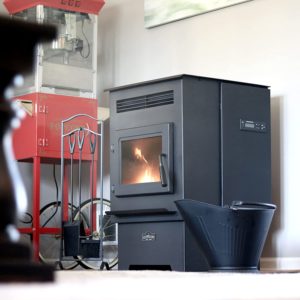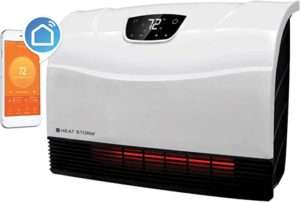This post may contain affiliate links which means I may receive a commission for purchases made through links.

Most older homes have a baseboard heater running along the walls of each room to generate heat in the winter seasons. However, these systems have their set of drawbacks, making homeowners look for the best alternative to baseboard heating.
For instance, baseboard heating systems may take up unnecessary space in your and increase your energy bills. To avoid these drawbacks, many people are now shifting towards more energy- and cost-efficient heating systems. Surprisingly, replacing your old baseboard heater is easier than you think.
In this article, I’ll take you through some incredible alternative options to baseboard heaters that may be perfect for your home and energy needs! Let’s get into it!
7 Alternative options to baseboard heating
-
Solar heating
Solar heating is one of the advanced ways for heating your home. It’s highly efficient and eco-friendly, making it one of the best techniques for ensuring your home has the perfect temperature. Specifically, solar heaters use energy from the sun to heat a fluid in the system and transfer that heat to a storage system for later use.
The only challenge with this approach is the initial cost is relatively high. However, it will help you save a lot of money on your energy costs in the long run, making it a viable alternative to baseboard heaters.
-
Wood heating
Wood heating is a classic option for heating your home. You can either use it with a forced-air duct system or use wood logs in a wood stove to generate fire. This will then radiate heat through the top of the stove and the walls.
Another incredible wood heating option is the use of pellet stoves. As the name suggests, these stoves use pellets that are stored in a hopper to feed a fire. This eliminates the need for constantly feeding the stove to maintain the flame.
On the downside, wood heating is an older and less effective technique of heating the entire home. However, if you need to consistently heat 1 or 2 rooms, it may be a better option than baseboard heating.
-
High-efficiency furnaces
A modern high-efficiency furnace can be a great alternative for old baseboard heaters. High-efficiency furnaces use less energy and fuel than older models by up to 30%. Therefore, it’s a great way to reduce future energy usage and costs, while minimizing your carbon footprint.
In addition, replacing your baseboard heater with high-efficiency furnaces helps to reduce the noise associated with old baseboard heating units. Even better, these furnaces produce more uniform heat in your home and maintain the indoor temperature at a more consistent level.
-
Heat Pumps
A heat pump is an excellent alternative to baseboard heaters if you’re planning to replace them with a central air unit or furnace. It will maximize the efficiency of your heating system while minimizing the use of baseboard heaters to provide more comfort. Moreover, heat pumps can be powered by electricity, making it easy to shift from your old baseboard heaters.
At the same time, heat pumps can be used to move heat from warm spaces to cool spaces. In other words, you can use a heat pump to cool and heat your home, depending on the season. This makes them a great option for controlling your indoor temperature all year round.
In addition, since heat pumps move heat instead of generating it, they offer the same amount of comfort as baseboard heat for a quarter of the operating costs. As a result, they’ll help to reduce your energy bills by up to 40% and dehumidify your home.
However, heat pumps require a different type of maintenance than baseboard heating. For instance, unless you’re using a ductless heat pump, this heating system requires a duct system that runs throughout your home. This ductwork stores and distributes air to various rooms in your home. More importantly, the ducts should be cleaned regularly to ensure the air is free from harmful chemicals and mold buildup.
-
Ductless Heat Pumps
Ductless heat pumps are another popular and convenient alternative to baseboard heating. Best of all, they will help you cool and heat your home, while saving you 25 – 50% on your electricity bill. On top of that, they take up less space than baseboard heaters, while providing better performance.
Another interesting feature about ductless heat pumps is that they’re more compact and have very quiet heating systems. This makes furniture placement in your home much easier. At the same time, they deliver efficient cooling and heating through the refrigeration that connects the outdoor system to the indoor units.
Lastly, since these heating systems are standalone units, they give you more control when it comes to adjusting the temperature of a specific room. Besides, they can only heat 1 or 2 areas in your home at a particular time, giving you a more accurate temperature in less time.
Underfloor heating offers the same type of low-grounded heat as baseboard heaters. Moreover, they either use a warm water system or electric heating wires to spread heat throughout the floor. However, unlike baseboard heating, underfloor heating systems ensure uniform heat distribution throughout your home and allow you to comfortably walk barefoot on the floor.
As for heat output, electric underfloor heating systems produce about 12 watts of energy per square foot. Surprisingly, they don’t use more electricity than baseboard heaters, yet they’re efficient enough to warm up most rooms in your home. Best of all, they don’t take up any valuable space in your home since they’re hidden under the floor surface.
-
Infrared Heating

Infrared heaters follow the same basic operating principles as the sun. They emit infrared rays that hit different objects in your room to transfer their heat and warm the surrounding space. As a result, infrared heaters are always super-efficient, regardless of the surrounding temperature. Moreover, they ensure that heat losses are kept to a minimum since they convert all the energy they receive into heat.
Another benefit of infrared hits is that they don’t dry up the area they are installed in. This helps them to prevent some baseboard heating dangers like skin, eye, and throat irritation caused by dry air environments. Moreover, this makes them healthier than baseboard heating since they don’t deplete the humidity in the room.
Lastly, infrared heaters work quietly, use less power, and require minimal maintenance since they have no moving parts or air filters.
Final Word
Baseboard heating is a fairly modern way of providing heat in your home. However, there are some incredible alternative options to baseboard heating you can use to avoid the drawbacks associated with this form of heating. However, if you still insist on using a baseboard heater, replace your old model with the best hydronic or electric baseboard heater on the market today.
